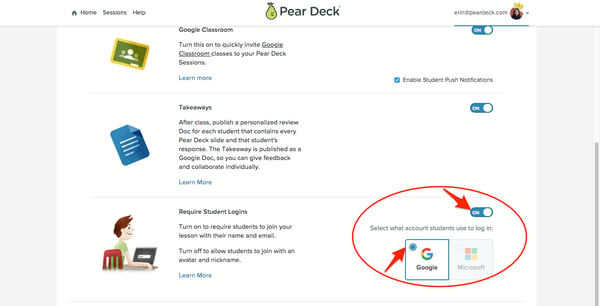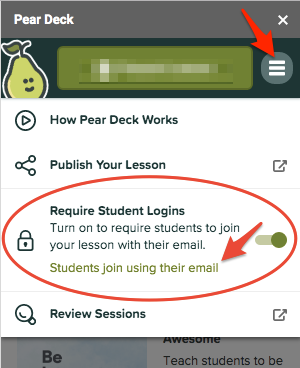How Students Join a Pear Deck Session
How Students Join a Pear Deck Session
When you’re done creating your interactive Pear Deck Slides, launch your presentation to start a new Session. Students must join your Session to see your slides and respond to your interactive questions on their screens.
Below, you can find a Quick Guide for Students to join a Session, and a Login Settings Guide for Teachers.
Quick Guide for Students
Students don’t need to create a Pear Deck account to join Sessions, but they may need a Google or Microsoft Office 365 account to join a Pear Deck Session if the teacher requires it in their Settings (see the next section).
1. The teacher starts a Pear Deck Session and gets the Join Link or Join Code to share with students.
2. The student either:
- Clicks on the link OR
- Goes to joinpd.com and types in the Join Code
- If the presenter has required email login, the student will be automatically logged in with, or prompted to choose, their email account before entering the Session.
3. Now the student is in the Student View, where they can see the presentation slides and respond to interactive questions.
Login Settings Guide for Teachers
As the teacher (presenter) you get to determine whether students join your Sessions with an email account or anonymously. Login settings are held for all future Sessions. If you turn OFF student login and let students join anonymously, you will not be able to retrieve their names or email addresses from any Sessions you present going forward. Turn ON student login anytime to start collecting email addresses and names again.
Also Read : Valentine Day 2024 Quotes in English
Turn on Email Login so Students Join with an Email Address
When you require students to join with an email address, they must enter or select their email account after submitting the Join Code at joinpd.com or clicking on the Session Join Link. Their email addresses and names are automatically saved along with their responses (but never displayed on the Projector View). You can easily review students’ work and see who left each response in the Dashboard, Takeaways™, or by exporting responses to a Google Sheet (Takeaways™ and spreadsheet exports are available with Google).
Require email login if you want to see who submitted responses for any reason, during or after the Session. It’s the only way to collect their names!
1. Your Pear Deck Home Settings page
- Go to Pear Deck Home.
- Click on your person icon.
- Click My Account.
- Click Settings.
- Go to the Require Student Logins section. Click ON. Then, choose the account type you want students to use to join your Sessions. When you require login, you can only allow one email account type to join your Session. Going forward, when you present your lesson and students go to joinpd.com, they will be prompted to join with an email account after entering the Session Join Code or clicking the Join Link. This setting applies to all further Sessions until you change it.

2. The Pear Deck Sidebar
- Open the Pear Deck for Google Slides Add-on or the Pear Deck for PowerPoint Add-in.
- Click on the menu button.
- Go to Require Student Logins.
- Turn it on (green). When you present your lesson, students will enter the Session Join Code at joinpd.com or click the Session Join Link, and they will then be required to join with the email account type that you selected in your Settings menu.

Let Students Join Anonymously
When you let users join anonymously, they are not prompted to enter email account information. Instead, an avatar and nickname is assigned to each student. Participants can respond to your interactive slides, but you won’t see their names. Turn OFF student login on the Settings page and in your Pear Deck sidebar menu (see the steps above) to make login anonymous.
When you turn off student login and let students join anonymously, you will not be able to retrieve their names from any Sessions you present going forward. Turn the setting back ON to collect student login information again from future Sessions.
Here’s what the presenter sees when login is anonymous:
![]()
Here’s what the participant/student sees:
![]()
If this article didn’t answer your question, please email Help@peardeck.com!
Create a Pear Deck assignment
1. Open Schoology.
2. Go to Courses. You can create a new course or open an existing one.
3. On the Course page, click Add Materials and select Add File/Link/External Tool.
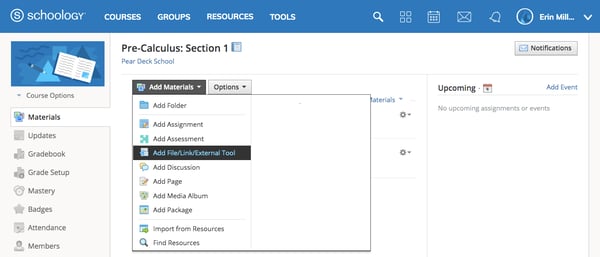
4. In the pop-up window, select External Tool.
5. In the Tool Provider section, click on the drop-down menu and select Pear Deck.
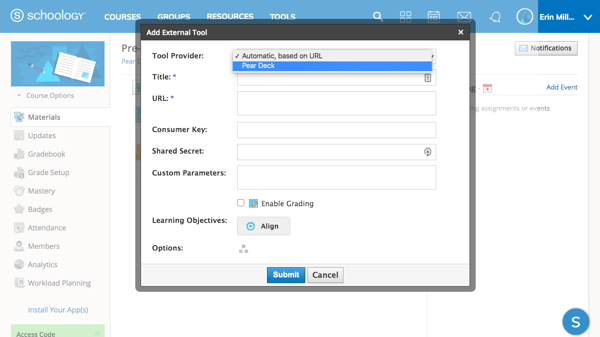
6. Customize your assignment with a Title, Parameters, Grading enablement, etc. The URL, Consumer Key, and Shared Secret have already been installed for you.
7. Make sure to check the Enable Grading box if you want students to be able to click Submit Work in Schoology when they’re done with this lesson.
8. Click Submit to return to the Courses page. Your assignment is now published. If you aren’t ready to continue configuring the session, you can un-publish the assignment until you have configured the session.
Start your assignment
1. Have an interactive Pear Deck for Google Slides or PowerPoint Online Slides file ready to present. The presentation files are saved automatically in your Google Drive or OneDrive and you will select the one you want to present to students in Step 5.
2. Open the Schoology Courses page.
3. Click on the Pear Deck assignment you created. Note that you can give it any title when you create the assignment, but in this case I called it Pear Deck Assignment:

- Note that the assignment is now published. You may want to use the Gear icon to un-publish the assignment while you configure the session so it does not display for your students until you are ready.
- Click on the Select a file from Drive or OneDrive button. The first time you present a Pear Deck file in Schoology, you will be required to log into Pear Deck.
4. In the file chooser, search for and select the Google Slides or PowerPoint Online Slides file from Drive or OneDrive that you want to present to your students.
5. Choose your Lesson Mode. Depending on the Lesson Mode you choose, one of the Presenter Views (Projector or Dashboard) opens for you in Schoology.
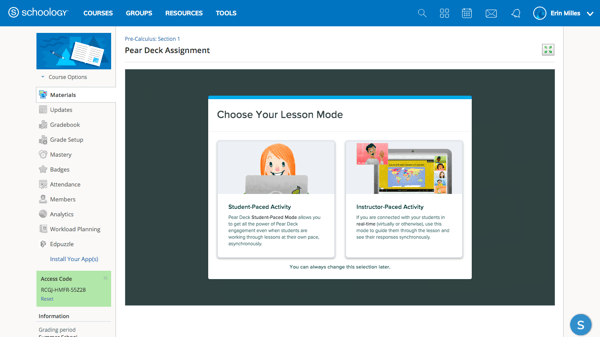
6. Student-Paced Mode (asynchronous; recommended for this integration): When you choose this Mode, the private Dashboard View opens so you can see students’ names next to their responses in real time. When students open this assignment, they get simple navigation controls on their Student View, allowing them to scroll through the slides in your presentation Session and respond to the interactive questions.
7. Instructor-Paced Mode (synchronous): When you choose this Mode, the Projector View opens and responses are anonymous by default on this View. The Student View of the slides syncs up to your slide on the Projector View, so you will need to click through the slides so students can see them and respond to interactive questions.
8. You have now created a new Pear Deck Session for your class within Schoology.
